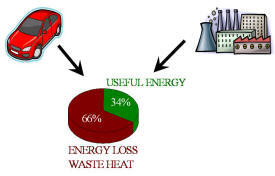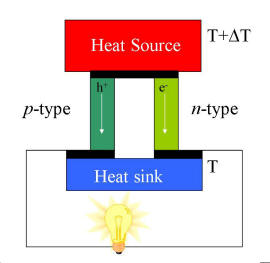Thermoelectric Materials
Powell and Vaqueiro
Why energy recovery?Much of the energy in industrial processes and automobile engines is lost as “waste” heat. In an automobile engine, around 35 kW are released to the atmosphere in the form of hot exhaust gases and another 35 kW through the engine cooling system. Recovery of only 10% of waste heat from vehicles would result in a reduction, by 12 million tonnes, in CO2 emissions in the UK. |
 |
What are thermoelectric materials?Thermoelectric materials convert thermal energy into electrical energy and find applications in devices for power generation. Such devices enable energy harvesting from heat, and can therefore be used to increase energy efficiency and reduce CO2 emissions. Click on the video below, made by an undergraduate (Svitlana Shadrina), to watch a demonstration of thermoelectric power generation. |
 A thermoelectric couple consists of two semiconducting materials (p- and n-type) joined by a metal junction. Thermoelectric devices are composed of several of these couples. The main limitation of commercially available thermoelectric devices is their low efficiency. |
|
The fundamental problem is that a good thermoelectric material must be a good conductor of electricity (like a metal) and a poor conductor of heat (like an insulator). This combination of properties is extremely unusual, and therefore finding high-performance thermoelectric materials is challenging. Some of our research in thermoelectrics has been funded by the EU project "An innovative very low-cost thermo-electric technology for large-scale renewable solar energy applications", InnovTEG. |
|
.jpg)